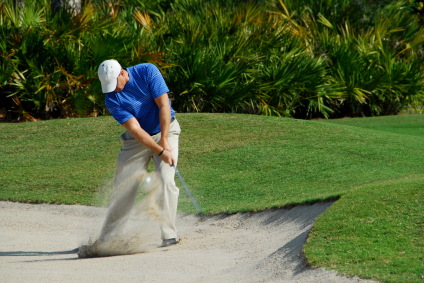I’ve just piped a drive, and now I’m facing a short iron to a green with a large bunker protecting a front pin. My trusty range-finder gives me exactly 150 yards to the flag. It’s a simple calculation from here, right? 8-iron is my 150 club. No problem.
Five minutes later, I’m awkwardly situated under the lip of that front bunker, trying my best to remember the “how to advance the ball from a plugged lie” tip I read last week in Golf Digest.
Sound familiar? In any given round of golf, how many of your approach shots end up short of the green? Count the next time you play. You will likely be shocked at what you find.
For most of us, the source of the problem lies not in the swing we make but in the decisions we make prior to the swing. This should come as good news, as making better decisions is a lot easier than making better swings, especially for the average weekend warrior. So, let’s try this again.
I’ve just piped a drive, and now I’m facing a short iron to a green with a large bunker protecting a front pin. My trusty range-finder gives me exactly 150 yards to the flag. I’m tempted to pull an 8-iron, but I reconsider:
1. I may think I can carry an 8-iron 150 yards, but this is self-delusion at best. Years ago on the driving range I hit one or two 146-yard 8-irons that bounced and rolled to the 150 flag, and I’ve been the proud “I can hit 8 from 150” guy ever since. I’ve been living a lie, and I know it. (Add 4 yards.)
2. It’s 65 degrees outside, and I’m accustomed to playing on days that are much warmer. On average, a golf ball will carry 3 to 4 yards less for every 10-degree drop in temperature. (Add 3 yards.)
3. There’s a slight right-to-left crosswind, and my natural shot shape is a fade (a slight curve from left to right). Fading the ball into the direction of the breeze will knock some distance off. (Add 3 yards).
4. My ball is situated on a bit of an upslope in the fairway. An upslope adds loft to the club, effectively turning an 8-iron into something between an 8 and a 9-iron. (Add 3 yards.)
5. For a front pin guarded by a front bunker, short is dead. Long is the better spot to miss. (Add 5 yards.)
6. This is the big one. I’m an amateur golfer. I rarely hit the ball in the center of the clubface. Instead of planning for that 1 in 100 shot that comes off as pure as an Albert Pujols homerun swing, I should anticipate my normal mishit. (Add 5 yards.)
So after all this, my effective distance is 173 yards. This should have been a 6-iron from the start. I know, for some of you it’s hard to rationalize a 6-iron from 150, especially after watching Phil Mickelson blast a 6 from 207 at the Masters, but the truth of the matter is that if we amateurs are ever going to improve our scoring (remember, golf is about scoring, not how far we can hit the ball) we’re going to have to swallow our pride and start hitting the right club.
Next time you’re faced with an approach shot of 150 yards, resist the temptation to hit your “150 club.” Your 150 club doesn’t exist. Instead, think about what club will allow you to carry the ball to the safe part of the green under the conditions you’re given.
Yes, you may have to tell your friends you hit 6-iron from 150, but you’ll be putting for birdie while they’re shoveling their way out of the front bunker.
